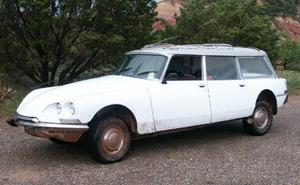|
|
The DS (also known as Déesse, or Goddess, after the punning initials in French) was a model of CitroŽn automobile manufactured and sold between 1955 and 1975. The DS is characterized by long, smooth, fluid body lines, a hydraulic suspension system, front-wheel drive, and a large, preternaturally comfortable interior.
Model History
Citroen_Ds100.jpg
After 10 years of development in secret as the successor to the venerable Traction Avant, the DS 19 was introduced on October 5, 1955 at the Paris Motor Show. The car's appearance and innovative engineering captured the imagination of the public and the automobile industry almost overnight. 743 orders were taken in the first 15 minutes after opening of the show, the total order count for the show was 12,000.
The high price tag, however, hurt general sales, and a submodel, the ID (Idée, or Idea), was introduced in 1957 to appeal to more cost-conscious buyers. The ID shared the basic body design with the DS, but had more traditional features under the hood. A station wagon variant, the Break ID, was introduced in 1958.
In September 1962, the car was restyled with a more aerodynamically efficient nose, better ventillation and one or two other improvements. In 1965 a luxury upgrade kit, the DS Pallas (after Greek goddess Pallas), was introduced. This included comfort features such as better noise insulation, leather upholstery and external trim embellishments.
In 1967 the model line was again restyled. This version had a more streamlined headlight mount, giving the car a notably shark-like appearance. The headlights swivelled with the steering wheel, allowing the driver to see around turns. The station wagon edition, the Break (called the ID Safari on the UK market), was also upgraded. The hydraulic fluid changed in all markets (except the US) to the technically superior LHM (Liquide Hydraulique Minéral).
Rarest of DS variants, a convertible was offered from 1958 until 1973. The convertibles were mostly constructed on the estate floorplan for added structural strength. The convertibles were built in small series by French carrossier Henri Chapron, for the CitroŽn factory. In addition, Chapron also produced a few coupes and enlarged sedans (DS Lorraine for instance).
The DS and ID powerplants evolved throughout its 20 year production life. The initial 1911cc 3 main bearing motor (carried forward from the Traction Avant) of the DS19 was replaced in 1965 with the 1985cc 5 bearing motor of the DS19a (called DS20 from Sept 1969) The DS21 was also introduced for model year 1965. This was a 2175cc, 5 main bearing engine. This engine received a substantial increase in power with the introduction of Bosch electronic fuel injection for model year 1970 making the DS one of the first mass-market cars to use electronic fuel injection. Lastly, model year 1973 saw the introduction of the 2347cc engine of the DS23 in both carburetted and fuel injected form.
IDs and their variants went through a similar evolution, generally lagging the DS by about one year. ID models never received the DS23 engine or fuel injection.
The model was phased out in 1975 (Saloon) and 1976 (Break) in favor of the new CitroŽn CX.
Throughout its model lifetime the DS managed to remain well ahead of its time. It featured power disc brakes, the previously mentioned hydropneumatic suspension including an automatic levelling system, power steering and a semi-automatic transmission system. Above all the smooth, aerodynamic body lines gave the car an amazingly futuristic appearance.
DS in Popular Culture
To a France still deep in reconstruction after the devastation of World War II, and struggling to find its identity in the post-colonial world, the DS was a symbol of French ingenuity. More importantly, it posited the nation's relevance in the Space Age, as the car bore a remarkable resemblance to images of flying saucers just then becoming famous.
Structuralist philosopher Roland Barthes, in an essay about the car, said that it looked as if it had "fallen from the sky." [1] (http://www.id-ds.com/Pages/Citroen/DS.Barthes.html)
The DS was adopted as the official car for the French government for a number of uses – as police cars, as ambulances (in the station-wagon form), and even as limousines for the nation's highest officials. President Charles de Gaulle was a big fan of the DS, and used one for all official functions. He survived an assassination attempt on 22 August, 1962 (a machine gun ambush by the Organisation de l'Armťe SecrŤte) because the DS he was on board was able to escape on only three working tires, thanks to its hydropneumatic suspension.
Outside of France, the car's radical and cosmopolitan image and design appealed to non-conformists. An United States advertisement summarized the car's main selling point: "It takes a special person to drive a special car."
The car is seen in many films and television shows, notably Back to the Future, The Day of the Jackal, and Buffy the Vampire Slayer. In the 1967 film, Le Samourai, (http://www.imdb.com/title/tt0062229/combined) Alain Delon's (http://en.wikipedia.org/wiki/Alain_Delon) hitman character carried a large ring of keys that enabled him to steal any DS he encountered. A 2000 movie by Clara Law called The Goddess of 1967 [2] (http://www.imdb.com/title/tt0255195/) is entirely devoted to the DS.
See also: design classic.
| Preceded by: CitroŽn Traction Avant | Succeeded by: CitroŽn CX |
de:CitroŽn DS
fr:CitroŽn DS
nl:CitroŽn DS
sv:CitroŽn DS
external links
- DS links CitroŽn World (http://http://home.versatel.nl/CitroenWorld/ds-id.htm)
- DS on the ROAD! (http://home.versatel.nl/citroad/ds.html)
- P CITROňN DS (http://home.versatel.nl/P-citroen/ds.html)
- DS district CitCity (http://home.versatel.nl/CitCity/DS/)
- DS articles citroenz.nl (http://www.citroenz.nl/idds.htm)

